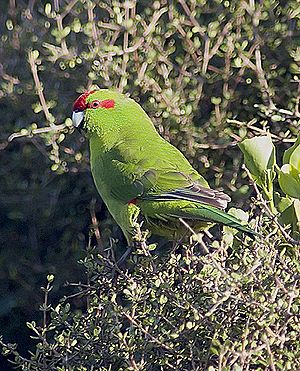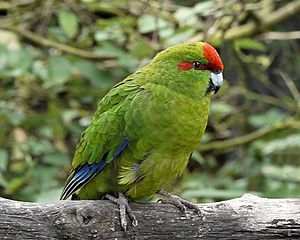Red-crowned parakeet facts for kids
Quick facts for kids Red-crowned parakeet |
|
|---|---|
 |
|
| Conservation status | |
| Scientific classification | |
| Genus: |
Cyanoramphus
|
| Species: |
novaezelandiae
|
| Synonyms | |
|
|
The red-crowned parakeet (Cyanoramphus novaezelandiae) is also known as the red-fronted parakeet. In the Māori language, it is called kākāriki. This small parrot lives in New Zealand.
It has bright green feathers and a red pattern on its head. This bird can eat many different foods. It also lives in various types of places. The red-crowned parakeet was once considered "near threatened." This was because invasive animals hunted them. But now, their numbers are stable, and they are listed as "least concern." This species used to live all over New Zealand. Today, you can find them in only a few areas on the main islands and some smaller islands nearby.
Contents
About the Red-Crowned Parakeet
The red-crowned parakeet belongs to the group of birds called Psittaciformes, which are parrots. It is part of the Cyanoramphus genus. This group includes 12 types of parakeets.
Scientists once thought that C. novaezelandiae was the same as other parrots. These parrots lived on New Zealand's faraway islands, New Caledonia, and Norfolk Island. But now, scientists have given these other parrots their own species names.
Different Types of Red-Crowned Parakeets
There are a few types, or subspecies, of the red-crowned parakeet:
- Mainland red-crowned parakeet, C. novaezelandiae novaezelandiae
- Chatham red-crowned parakeet, C. novaezelandiae chathamensis
- Kermadec red-crowned parakeet, C. novaezelandiae cyanurus
Closely Related Parakeets
Many Cyanoramphus species look very much alike. Because of this, some were only recently recognized as separate species. This happened after scientists used new genetic tests.
Some species that were once thought to be subspecies of the red-crowned parakeet include:
- Reischek's parakeet, C. hochstetteri
- New Caledonian parakeet, C. saisseti
- Lord Howe parakeet, C. subflavescens
- Norfolk parakeet, C. cooki
- Forbes’ parakeet, C. forbesi: There is still some discussion about whether the Forbes’ parakeet is its own species. It was first described as a separate species. Later, some thought it was a subspecies of the red-crowned or yellow-crowned parakeet. However, newer genetic studies suggest it should be its own species. It is the closest relative to the red-crowned parakeet. But it has small differences in its voice, color, and how it looks. It also acts and lives a bit differently. These birds rarely mate with other types of parakeets. This suggests they prefer their own kind.
What They Look Like
Adult Parakeets
Red-crowned parakeets are green parrots with long tails. You can easily spot them by their bright yellow-green feathers. They also have a bright red forehead, red around their eyes, and a red stripe above their eyes. They have red patches on their lower backs too. When they fly, you can see their dark blue outer wings. Their legs and feet are grey or light brown. Their beaks are white to grey with a black tip.
Female Parakeets
Female parakeets are a bit smaller than males. They have a yellow stripe under their wings. Their beak is also smaller and narrower.
Young Parakeets
Young red-crowned parakeets look a lot like adults. But their beak has a slight pink color. The center of their eye (iris) starts as dull black or brown. It turns more red as they get older. Young male parakeets also have a stripe under their wing, just like females.
Size of the Parakeet
Here are the average sizes of red-crowned parakeets:
| Body part | Size (mm) |
|---|---|
| Total body length | 230-280 |
| Wing length | 125-139 |
| Tail length | 115-158 |
| Bill length | 14-17 |
| Tarsus (lower leg) | 19-22 |
Sounds They Make
You can recognize red-crowned parakeets by their soft, musical chattering sounds. These calls are louder and deeper than those of the yellow-crowned parakeet. When they fly or take off, they also make a "ki-ki-ki-ki-ki" or "kek-kik-kek" sound.
Where They Live

Their Home
Red-crowned parakeets can live in many different places. These include thick temperate rainforests, coastal forests, and areas with scrub. They also live at the edges of forests and in open spaces. When they live in the same areas as yellow-crowned parakeets, red-crowned parakeets prefer forest edges and open areas.
Where They Are Found
Red-crowned parakeets used to live all over the North and South Island of New Zealand. But today, most of these populations on the main islands have disappeared. This is mainly because of predators that were brought to New Zealand by humans.
On the main islands, you can find them in large forest areas in Northland, Coromandel, and the central North Island. In the South Island, they have been seen along the West, South, and South-East coasts. However, these groups on the main islands are very rare. Most of the species now lives on Stewart Island/Rakiura and several smaller islands. These islands include Kapiti Island, Tiritiri Matangi Island, and Matiu/Somes Island. They also live on the Auckland Islands to the south. The other subspecies live on their own islands, like the Kermadec Islands and the Chatham Islands.
How They Behave
What They Eat
Red-crowned parakeets eat a wide variety of foods. They munch on flowers, fruits, seeds, leaves, and buds from many different plants. They also eat some small insects, like tiny aphids. Sometimes, they are fed mealworms. What they eat changes throughout the year. This depends on what food is available each season. In winter and spring, they mostly eat flowers. In summer and autumn, they mainly eat seeds.
Reproduction and Life Cycle
Red-crowned parakeets form pairs that stay together for breeding. A pair might stay together after one breeding season, especially if they had success raising chicks.
Courtship, where the male feeds the female, starts about two months before eggs are laid, around mid-October. In early October, males start taking their mates to look for places to build a nest. The male stands guard while the female carefully checks out a hole. She shows she likes a spot by going in and out of the hole many times. Then, the female digs a hole about 10–12 cm deep and 15 cm wide. She uses her upper beak and feet to do this. She chews wood chips from the walls to use as soft material for the nest floor. During all this nest building, the male stays nearby. He feeds himself and his mate. He also chases away other parakeets. Successful pairs have been seen using the same nesting spot year after year.
Nests are usually found in holes in large, healthy trees. But they can also be in other places. These include holes in cliffs, spaces among plant roots, old seabird burrows, and even human-made structures. Most nest entrances face north.
Eggs are laid from November to January, with most eggs laid in December. On average, a female lays 7 eggs, but it can be anywhere from 4 to 9. The eggs are oval and white. They have a slight shine that fades during incubation. Only the female parakeet sits on the eggs to keep them warm. While in the nest, she turns the eggs regularly. She also spends time sleeping, cleaning her feathers, or digging. This incubation period lasts from 23 to 25 days. The male visits the nest often to feed his mate by bringing up food from his stomach.
The eggs do not all hatch at the same time. Some chicks can appear several days after the first one. When they hatch, the hatchlings have only a few light grey down feathers. They weigh about 4.6 grams. They can already make loud, high-pitched sounds. However, the young are altricial. This means they are born completely helpless. They depend on their parents for everything. For the first few days, the mother feeds the chicks a clear, thick liquid. Later, they can eat solid food. Around day 9, when the nestlings can open their eyes, the male is allowed back into the nest. From then on, both parents feed their young. Thirty days after hatching, the chicks have feathers on most of their bodies. They have grown to about 83 grams. They then start to leave the nest. But they stay perched or on the ground near their nest. The parents still visit their young to give them food. It takes 10 days after fledging (leaving the nest) for the young birds to start finding their own food. They become fully independent 4 to 5 weeks after leaving the nest.
The timing of breeding and the number of eggs laid can be different for various types of red-crowned parakeets. This is because they live in areas with different weather and environmental conditions.
Status and Protecting Them
The red-crowned parakeet was once common across New Zealand's islands and mainland. There were huge numbers of them in the 1880s. But their numbers dropped sharply on the mainland. This was because they were easy targets for introduced species. These new predators included stoats, rats, and possums.
Bringing Them Back
Scientists have tried to bring these birds back to certain areas. Between 1976 and 1986, seventeen red-crowned parakeets were set free in the Waitākere Ranges near Auckland. This project was not watched closely, and it did not seem to work.
More recent attempts on Tiritiri Matangi Island, New Zealand, from 2004 to 2006, were successful. These showed that reintroducing the birds can work in places where there are no introduced predators.
Bird Disease
Recent studies on Little Barrier Island, New Zealand, found a disease called psittacine beak and feather disease (PBFD). This disease affects the local red-crowned parakeet population.
Culture
Language
In the Māori language, when people are talking loudly or gossiping, it is compared to kākāriki chicks calling in their nest. The saying is "Ko te rua porete hai whakariki" (just like a nest of kākāriki).
Keeping Them as Pets
The red-crowned parakeet is a common bird to keep as a pet. They are also quite easy to breed. You can find them in different colors, like yellow, cinnamon, and piebald (with patches of different colors).
- Colour mutants
See also
 In Spanish: Perico maorí cabecirrojo para niños
In Spanish: Perico maorí cabecirrojo para niños




